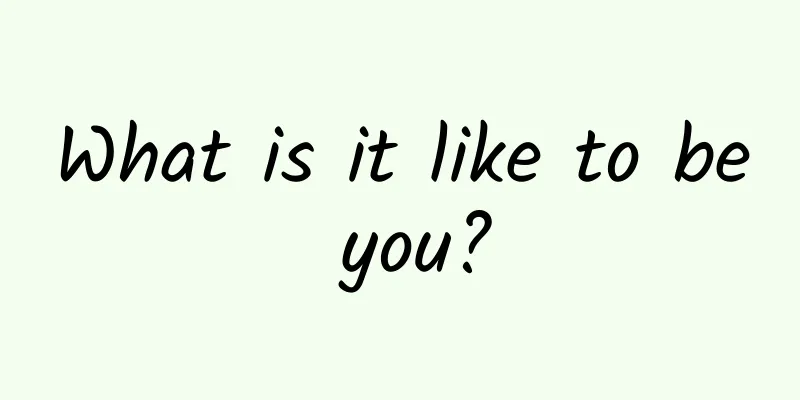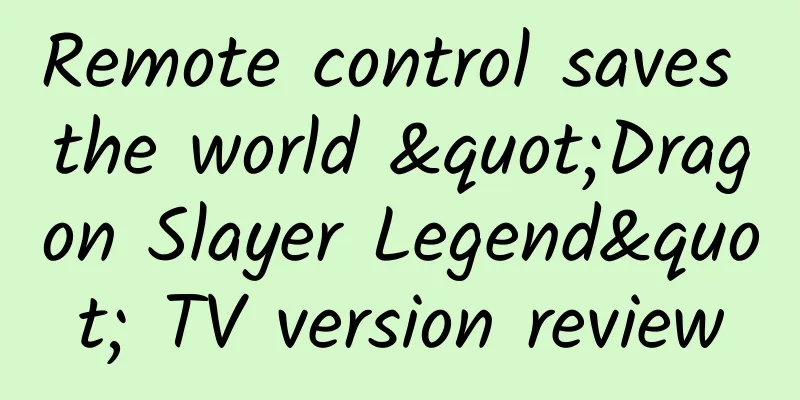What is it like to be you?

|
Leviathan Press: When we talk about character, we always seem to consider it as a relatively fixed phenomenon. But in fact, many cases in neurology have proved (such as Rosemary Kennedy, HM) that after part of the brain area is removed or diseased, your previous personality may disintegrate, or in other words, you are no longer the original you who appears on the outside. The author of this article therefore infers that this change causes the other self that originally existed in your brain to take over the previous self - given the amazing neuroplasticity of the brain ("The Boy Who Had Half His Brain Removed"), this statement is undoubtedly fascinating/terrifying. What is it like to be you? And by you, I mean you as the reader. This is one of the most important questions I struggle with, but in my opinion, it’s one that everyone should address! If you don’t understand why this is so important, please stop reading this article, stare at yourself in the mirror for a few minutes, repeat this question several times, and notice when you feel lost. Another famous exercise by Douglas Harding is to look at your feet, hands, elbows, fingers, and then your head. You will notice a screen that presents the world, not where your head should be. This means that the world is where your head should be. This exercise teaches you that you can never really see your head without the help of a picture, mirror, or other reflection. Honestly, you are not the head, but the world presented to you. Douglas Harding, The Endless Road. © wiki Another way to think about it is that as you read this, trillions of synapses in your brain are reacting electrochemically, but you are not aware of it. However, if I point at your toes, you know what your toes feel like. How do your toes feel at this moment? Is the air around you warm or cool? Now that I have asked you to pay attention to these questions, you have to be aware of these sensations. Right now, most of your thoughts are focused on the feeling in your toes or the air around you. That's what I mean by consciousness, or rather, semi-consciousness. If I hadn't pointed it out, you wouldn't be aware of it; however, now that I've pointed it out, you can't help but think about it. Many things happen semi-consciously, such as breathing. Are you breathing in or out? Once you focus your attention on them, they stay in the center of your awareness. However, there are some things you cannot be aware of, such as digestion. Although I have talked to some monks who claim to control their heartbeat and digestion and be aware of them, for this discussion we will assume that you have not yet mastered this ability. Then there are the things you are paying attention to. Think back to the example of your toes and your breath; you are paying attention to them on purpose. You are paying attention to these words; in fact, I think your experience will change from noticing the myriad changes of sensations (from noticing to semi-noticing and vice versa), through the stages of wakefulness and sleep, from birth to death. So far I have asserted that you are already paying attention to certain things, can begin to pay attention to other things, and can never be aware of or conscious of some things. But how is it that on the level of the brain, or at the unconscious level, those things that are not being conscious occur? The corpus callosum is an important band of white matter in the brain of higher mammals, connecting the left and right cerebral hemispheres. It is the largest band of white matter in the brain, and most of the communication between the two hemispheres is carried out through the corpus callosum. © UCSF Fetal Treatment Center It is undisputed that our brains are divided into two hemispheres. However, it is controversial that these two hemispheres play different roles in the way they represent the world. But I will follow the view that the two hemispheres represent the world we experience in different ways. For example, if you are reading this article in a room, you can understand that your attention to being in a room is the result of your right hemisphere, because the right hemisphere integrates things into a whole. But on the other hand, because of the role of the left hemisphere, you will notice the chair, bed sheets, clothes or other specific objects in the room. When I say "the right hemisphere does this" or "the left hemisphere does that," the reader should note that in any given person, both hemispheres are actively engaged at any given time. Unless one hemisphere is damaged or removed, both hemispheres are active at the same time. Almost all thought processes, even all mental states, require the participation of both hemispheres: information is constantly being passed between the two hemispheres. Information can travel in either direction several times a second. The activity that scans show is a function of the threshold at which it is set: if the threshold is set low enough, one will see activity almost everywhere in the brain all the time. But, at an empirical level, the world as we know it is integrated by the work of the two hemispheres, each with its own way of understanding the world—its own “view” of it. It is unlikely that this integration is evenly split. There is also the issue of individual differences in hemisphere dominance and brain lateralization. I will talk about the "right hemisphere" and the "left hemisphere" throughout this article as if these concepts are universally applicable. But they are not. These terms are meant to be generalizations. The two hemispheres of the brain are connected by the corpus callosum, a "C"-shaped bundle of nerve fibers. The corpus callosum contains about 300 million to 800 million fibers that connect topologically similar regions in the two hemispheres. However, only 2% of the neurons in the cerebral cortex are bound by this bundle of nerve fibers. What's more, the main purpose of many of these connections is actually inhibition - in other words, to block interference from the other hemisphere. If you're stumped, this means, bluntly, that the left and right hemispheres don't communicate with each other (if you're a professional cognitive scientist, neurologist, surgeon, or anyone who has read a lot of literature on the subject, please note that this is an oversimplification and is not meant to be defamatory). Phineas Gage (1823-1860) survived a tamping iron shot through his head. © MedicineNet The reason for delving into lateral dominance is to bring up my next point, which concerns a man named Phineas Gage. He survived an accident in which a large iron rod was driven completely through his head, destroying much of the left frontal lobe of his brain. This injury reportedly had a dramatic effect on his personality and behavior for the remaining 12 years of his life—enough to cause his friends to believe that he was (at least for a while) "no longer Gage." This suggests that when a person only has access to part of their hemisphere, their personality can completely change. It's not outrageous that Phineas Gage's right frontal lobe would take over the functions of his left frontal lobe. But how those functions are performed can affect the person's personality. However, I have a hard time understanding this idea: When Phineas Gage's left frontal lobe was damaged, the brain did not create a new personality for him. The right frontal lobe could always participate in forming these behaviors or the personality itself. But after the left frontal lobe was completely destroyed, the personality of the right frontal lobe became dominant. Another thing to note is that the brain is divided into four lobes, but damage to just one lobe can cause such dramatic changes. This is a quasi-Freudian picture of the brain. But the point I want to make is this: Injury can change an area of the brain. You may bring into consciousness other personalities that you were not aware of before. The controversial point I want to make is that your brain helps glue together multiple personalities, but only one personality becomes dominant and becomes the center of consciousness. We experience this interweaving of multiple personalities every day. Take our minds, for example. Every one of us (except robots) has a mind. But what exactly does it mean to have a mind? Well, almost everything you experience is a mind. Human activity, from the most constructive, like finding a cure for COVID-19, to the most destructive, like creating biological weapons, is the product of thinking by people like us. But in our heads, we live under a kind of tyranny. We usually think of these thoughts as something we create, but to borrow from the Buddhist tradition, the self is also a mental construct. Anyone who has tried meditation knows that the moment you focus on your breath, you "see" your mind. It is the most rambling, chaotic, confrontational, rude, and intolerant person you have ever met. It's like having a crazy roommate in your head who will never shut up, but you can't control it. So where does this idea come from? To return to my controversial point, I think there is a person/personality in your head that exists in a quasi-Freudian way, but never completely controls your consciousness and thoughts. However, these ideas do gain traction. This could explain multiple personality disorder, a mental disorder where a person has more than one personality. Somehow, the unconscious (pardon my wording) personalities also take over. So when an unfortunate event like what happened to Phineas Gage occurs, the part of the brain that takes over from the damaged area also brings with it its set of personalities, which become the center of our consciousness or dominate the way we see the world. People are not aware of this until something like this happens. So, to sum up, there are many people coexisting in your head, all with different traits, opinions, ideas, thought processes, personalities, flaws, strengths, sexual preferences, beliefs, desires, goals, and the list goes on. Yet, most of them never take center stage. By Jehanzaib Sajid Kabir Translated by Amanda Proofreading/Yord Original article/jehanzaibsajid.medium.com/the-divided-mind-60fd45d499fb This article is based on the Creative Commons License (BY-NC) and is published by Amanda on Leviathan The article only reflects the author's views and does not necessarily represent the position of Leviathan |
<<: Can you see the vortex of Coriolis force in the toilet?
>>: The largest pearl in the world is as heavy as a husky
Recommend
If your product has no unique features, how can you attract users’ attention?
Among a bunch of products with similar selling po...
Why do humans wipe their butts after defecation, but animals don't?
Source: Dr. Curious...
There was a tornado last night, and the trees were uprooted! How to escape in a tornado?
According to the official Weibo of Guangdong Prov...
Build a complete product data operation system in 11 steps!
Many people's understanding of data operation...
A little change on the table may enhance your immunity
Sometimes, food is also medicine, and more and mo...
What exactly is a tower company?
Not long ago, China Mobile, China Unicom and China...
Chery Fengyun T9 and BYD Song L DM-i, which one is more worth buying?
On October 13, Chery announced the launch of its ...
Twitter officially launches Periscope. Can it compete with Meerkat?
[[130843]] The popularity of the video live strea...
In the rainy season, cities turn on the "sea-viewing mode"? "Sponge" makes cities "water-absorbent"!
In recent years, many cities have turned on the s...
Android smartphone outlook for 2017: Full-screen smartphones explode, Huawei and Samsung compete for first place
According to foreign media reports, there are onl...
Samsung's first Tizen phone review: a failed Android clone
After years of hype, we finally saw the world'...
China's first! Officially released
Recently, my country's first desktop operatin...
How to finish a month's worth of articles in just one hour? Only 6 steps!
The source of content has always been the most tr...
Real or Fake Monkey King? Sorry, I am actually a little orchid~
Auditing expert: Yang Yanhui, Senior Garden Engin...
What are the number ranges for 400 telephone numbers?
When enterprises are handling 400 telephone numbe...

![Ma Ge Python Full Stack + Crawler + Data + AI [2022]](/upload/images/67cc025b8fcc9.webp)







